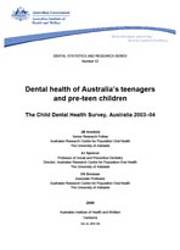Summary
The Child Dental Health Survey provides national information on the dental health of children attending school dental services in Australia. This report describes and discusses the survey and presents analyses for the combined years 2003–04. The data cover more than a quarter of a million children from all states and territories except for New South Wales.
Teenagers
- Teenage children have been identified as being at increased risk of dental disease.
- Between 40% and 57% of 12–15 year old teenagers had some history of decay in their permanent teeth—that is, one or more decayed, missing and filled permanent teeth.
- On average 12 year old children had slightly more than one decayed, missing and filled permanent tooth per child, while 15 year old children had two decayed, missing and filled permanent teeth on average.
- The 10% of teenagers with the most extensive history of permanent tooth decay had between five and eight permanent teeth affected, which was about 4.5 times the national average of decayed, missing and filled teeth.
Pre-teen children
- Nearly half (48.9%) of 6 year old children had a history of decay in the deciduous (‘baby’) teeth—that is, one or more decayed, missing and filled deciduous teeth.
- On average, 6 year old children had two decayed, missing and filled deciduous teeth per child.
- The 10% of 4–6 year old children with the most extensive history of deciduous tooth decay had more than nine deciduous teeth affected, which was about 4.5 times the national average.
Conclusion
- Decay experience is relatively common in both teenage and pre-teen Australian children.
- A minority of children experience a greater than average burden of disease.
- The lack of national data on older teenage children aged 15–17 years means that it cannot be determined whether or not the older teen years are a period of increased risk of dental disease.



